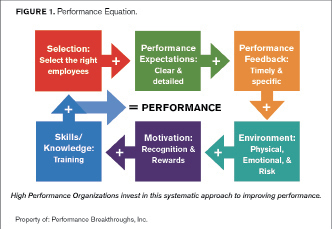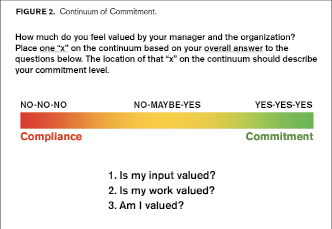
By Jeffrey Parks and Cheryl Hilvert
Most local government managers would agree that they have rewarding, yet at times extremely difficult, jobs. Whether it is walking the fine line between administration and politics, addressing ever-increasing resident demands, responding to emergencies, or handling seemingly impossible problems, a manager will face many issues that demand attention.
These challenges require the successful manager to use a combination of leadership and management skills that lead the organization toward higher performance and organizational excellence.
The importance of effective personnel management is clearly one of these challenges and is even more significant in an era of reduced staff and diminished resources. Managers and organizations that focus on organizational excellence not only do basic human resource functions well, but they also focus on the important work of empowering the workforce and maximizing employee performance.
The "Performance Equation"
Managers who seek a high-performance work culture can get a needed boost to their efforts by following the approach outlined in Performance Breakthroughs, Inc.'s "Performance Equation" (see Figure 1). This systematic approach identifies six areas of work that are necessary to ensure maximum employee empowerment and performance and should be an important part of a manager's personnel management work.
Deliberate and creative work in each area will help a manager give employees the best opportunity for the development of task competence, the feeling of being valued, and a deep commitment to their organization.
1. Select the Right Employees
The performance equation naturally begins with the hiring process. Every manager, of course, wants to hire the best possible employees for their organization. Can you say, however, with all honesty that your organization's current hiring processes consistently deliver good results in a search for talent?
Traditionally, there has been more focus on the technical competency of applicants than on candidates' potential commitment to and fit with an organization. This has been true in both classified civil service processes and in processes that are not mandated by local or state law or union contract.
Regardless of the type of process, managers should look for ways to expand hiring processes to learn more about a candidate's character, passion, leadership potential, and teaming behavior as well as technical and task proficiency.
Dee Hock, founder of Visa, influences some of that thinking and is credited with this quote: "Hire and promote first on the basis of integrity; second, motivation; third, capacity; fourth, understanding; fifth, knowledge; and last and least, experience."
When hiring new personnel, high-performing organizations use a variety of approaches to learn more about the candidate and the person's values. Hopefully, you have already created great interview questions that allow you to learn about both candidates' technical experience (the "what") as well as "how" they do their job.
Examples include: Have candidates worked effectively in a team environment or do they prefer to work alone and why? How did they work through a particularly difficult work situation and what was the outcome? What examples can they provide of how they worked in accordance with your organizational values?
Organizations have also developed interview panels that include staff members from various parts and levels of the organization who can contribute valuable input to the hiring process. Check references, of course, and ask probing questions like, "Would you hire this person again and why?"
The bottom line is that expanding hiring processes can be necessary—even where civil service testing is the norm—to truly get to know the people who are applying for positions in your organization. This is an opportunity to get creative: Have a candidate go to lunch with you. Encourage the person to meet with peers in the organization. Ask the office greeter for impressions of the candidate.
Just remember to stay within the limits of employment law. These additional steps take time, but the cost of a bad hire is significant and can have long-term effects on an organization long after the person is gone.
2. Define and Share Performance Expectations
Next, high-performance-oriented managers continuously communicate to the employees what the organization stands for, what established values look like in day-to-day work activity, and how they will be measured. In short, they translate the organizational values into managerial expectations.
Most of us have a picture in our head about what excellence looks like. Employees cannot be expected to understand what someone's "picture of excellence" is without an explanation. Managers give staff members a lot of help when they take the time to think expectations through, commit them to paper, share them with the workforce, and make adjustments based on employee input. This removes the guesswork and communicates the behaviors and standards against which performance is measured.
Many organizations have values that refer to concepts like quality, responsiveness, customer service, communication, integrity, and more. Great managers use organizational values as a starting point to develop their own expectations by answering these questions:
• What does "quality" mean and look like to our organization?
• What do timeliness and responsiveness mean to us?
• What does good customer service look like and how should we deliver it?
• How do I want direct reports to communicate with me? (Note: Some managers are hands-on and want significant detail and want it almost immediately. Others only want to know when something bad has happened.) Great managers are explicit about how, when, and what level of detail they expect in communicating with staff members.
Responses will be different for every organization, and as an example, here are descriptors for the "What does 'quality' mean to our organization?" expectation:
• The financial reports and public (internal and external) documents you and your team produce are error free and do not require multiple rework due to math or grammatical mistakes and omissions.
•The products and processes you and your team develop are well-defined, well-communicated, accessible, reliable, and meet the intended purpose and function. You obtain input from employees who work the closest with you and from others prior to the final product.
• You manage team and department members in an effective manner. Issues and problems rarely escalate to the human resources department or to the local government manager if you are a department leader.
In general, the expectations are high-level statements consistent with your values that explain what you and your organization stand for and how you"ll evaluate performance. They facilitate better coaching, development, feedback, and accountability discussions.
3. Provide Timely, Specific Performance Feedback
Performance expectations provide the baseline for feedback discussions. Employees need to know and understand what's expected of them and how those expectations are going to be measured. When this is in place, feedback stands a much better chance of being effective.
Rule No. 1 in delivering feedback is to do it. It may not be the most pleasant task you do in your busy day, but it is one of the most important. Employees deserve it as does the rest of the organization. Most importantly, local government customers deserve it.
When delivering performance feedback, think of the acronym STICS:
Specific. Make sure the employee understands what is being conveyed. Be kind, but don't walk a mile to avoid conflict if bad news is needed. Feedback needs to clearly provide a message of what to do more of, how to do it, or what to change or stop doing.
Timely. Feedback should be provided soon after any "event" and should be ongoing throughout the year. Do not bottle up frustrations and save them for the annual performance appraisal. The annual appraisal should be a summary of a series of conversations between you and an employee, provide a path forward, and not contain any "surprises."
In context. Employee behaviors and work products can often be appropriate or inappropriate, depending on the situation at hand. Feedback has more meaning when you explain the context of what was happening at the time and why the behavior or work product could have been improved.
Credible. Managers must work hard every day to be credible to those who work with them. Maintaining consistency in approach, competence, integrity, honesty, plus demonstrating that they care about both the organization and the employees, will go a long way in both establishing and maintaining credibility.
Sincere. Feedback must be perceived by an employee as being congruent and sincere. All communications—both verbal and nonverbal—must have consistent messaging.
People want to know how they are doing. It's a basic human need. When performance feedback is delivered well, employee commitment to your organization is strengthened and performance improves.
4. Evaluate the Work Environment
Managers should always remember that the environment in which employees work is critically important to their performance and commitment to an organization. Often, the workspace, tools, and equipment are the first thought when it comes to environment.
Think beyond this simple definition and ensure that employees also have a safe and encouraging environment. When employees feel supported in generating new ideas and stepping out of their comfort zone to try new things that are consistent with management vision and values, high performance occurs. Provide what is necessary to make employees as successful as they wanted to be on their first day of employment.
5. Provide Motivation, Recognition, and Rewards
While most managers understand the need to inspire and reward employees, they should pay closer attention to the types of behaviors and recognition that actually make employees feel valued. When employees feel their needs, opinions, and professional and personal growth are valued, they generally have a higher commitment to the organization and higher levels of performance.
When employees feel valued only for the technical and task work they produce, they often lack commitment to the organization and may simply show compliance or produce the bare minimum in terms of contribution or work product.
The good news is that rewards don't always have to involve a gift or a pay raise. Recognition of a job well done in front of one's peers or a thank-you note from the manager are excellent ways to communicate appreciation, and, at the same time, motivate and enhance an employee's performance.
6. Offer Training and Employee Development
A key component in effectively managing your human resources is ensuring that employees get the training, coaching, and mentoring they need to develop the knowledge, skills, and confidence to perform well in their current job or prepare them for advancement in the organization.
Expand employee effectiveness by focusing not only on technical and task training but also on leadership, management, or any other type of professional development that can benefit the individual and your organization.
Assessing Progress
In addition to using the components of the performance equation (Figure 1), managers should also consider asking their employees for feedback on how the organization is encouraging and developing employee commitment and performance. This does not need to be an overly cumbersome or expensive process and instead can be achieved by using the simple continuum of commitment tool (see Figure 2).
To use this tool, print and distribute copies of the slide and ask employees to mark one "x" on the continuum based on an overall answer to the three questions. In other words, if they answer "yes yes yes," they should feel high commitment (volunteering, acting in the best interests) to the organization.
If their answers are "no no no," their "x" will likely reflect only compliance or a minimal energy and effort to the organization. A mix of answers or an "x" in the yellow area indicates lukewarm engagement and commitment.
The key is to find out where employee responses are along this continuum and develop actions that, with consistent application over time, will move their responses further to the right toward higher commitment and performance.
The Performance Equation as a Diagnostic Tool
In addition to being an effective road map for any manager in onboarding a new employee, the performance equation is also a great diagnostic tool for anyone who has an employee who may be struggling with their work product, a lack of understanding of what is expected of them, not adhering to the organization's values, or demonstrating a lack of commitment to the organization.
In these instances, simply review the performance equation, stopping at each step, and asking yourself what you have done to satisfy the work of each step: Is the employee the right one for the job? Were performance expectations clearly conveyed?
Have you provided timely and specific feedback to the employee? Does he or she have the right work environment and tools as well as your support and encouragement to do the work?
Also: Have you conveyed appreciation for his or her efforts or recognized a job well done? Have you had "accountability and/or support discussions" when the effort or product is substandard? Have you provided the necessary training for the employee to develop his or her understanding and knowledge to adequately perform the expected work?
If any of those answers are no, use the performance equation to identify where the breakdown is occurring and address what is missing. Go to the appropriate step in the equation and establish a plan for yourself and the employee for doing what's necessary to get the performance improvement you seek.
If the poor and weak performance persists and you can honestly say that you have done everything you can as a manager in following the systematic process of the performance equation, it may be time to make a hard decision about the employee's future with the organization.
The equation is a simple, yet systematic approach that can help managers provide the needed support and resources to both new and existing employees to maximize their performance and commitment to the organization. It is an effective road map to maximizing employee performance, and, ultimately, higher performance in your organization.
Jeffrey Parks is an organizational and executive coach, Washington, D.C., and a former director of training and leader development for the U.S. Coast Guard (JParks@Performance Breakthroughs.com). Cheryl Hilvert is a local government management adviser, Cincinnati, Ohio, a retired city manager, and a former director of ICMA's Center for Management Strategies (chilvert@zoomtown.com).


New, Reduced Membership Dues
A new, reduced dues rate is available for CAOs/ACAOs, along with additional discounts for those in smaller communities, has been implemented. Learn more and be sure to join or renew today!
